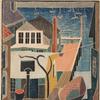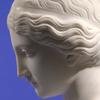The Curator's Eye Highlights Important Asian Works of Art on Offer During Asia Week New York
- NEW YORK, New York
- /
- March 10, 2015
As Asia Week New York begins, The Curator’s Eye (www.CuratorsEye.com) turns its spotlight on the hundreds of Asian art and artifacts on offer from their member dealers through their online exhibition. The Curator’s Eye presents an exemplary selection of rare pieces from dealers based all over the world, from a Tang horse, Ancient ritual wine ewers, antique Chinese porcelain, lacquered tea caddies, and ancient Buddhist sculptures.
Sakaida Kakiemon XII - Okimono or modernist, faceted Kirin
This Japanese Okimono or sculpture in the form of a modernist, faceted Kirin is made of white porcelain and signed on the reverse in under-glaze blue by the artist, Kakiemon Saku (Sakaida Kakiemon XII 1878 - 1963). Produced during the early Showa era, circa 1928 - 1940. In includes the tomobako or original box, with the inscription on the exterior of the lid: Hakuji Kirin Okimono or White Porcelain Kirin Sculpture.
A Papier-mâché Model of Atisha
Also available is a highly realistic and spiritual model of the great Buddhist teacher, Atisha (985 – 1054), from 15th century Tibet. He is portrayed dressed in the traditional patchwork robes of a monk, the pandita hat, a symbol of his higher learning, on his head, and seated upon a single lotus base. Atisha’s face, painted gold, is both stern and serene at the same time, his lips pursed as if about to utter a great teaching. His hands are delicately fashioned, one resting in his lap, the other posed in vitarka mudra, the gesture of transmission. His bare feet crossed in the full lotus position, toes flexed and extended in either agony or ecstasy. A striking sense of realism, with wonderful attention paid to detail, has been captured by the artist, using the papier-mâché technique, in which paper pulp is used to mold the figure, which is then covered with gesso before being painted in bright polychromes.
Mandalay Sacred Scroll Protector
This striking 19th Century Mandalay piece, the head of a ferocious Naga, was originally connected to a shrine trunk that held Buddhist scripture. The tail of this Naga would have curled around the other end of the scripture box mirroring the head. The Naga is the Celestial Snake or Dragon Deity, and traditions about the Naga are very common in all Buddhist countries. In many countries the Naga concept merged with local myths of great and wise dragons. The most notable of Buddhist Naga is Mucalinda, Protector of the Buddha. In the Vajrayana and Mahasiddha traditions there are even cases of Naga who received full enlightenment. The Lotus Sutra is believed to be a sutra revealed during the life of the Buddha that was hidden and protected by the Naga for five hundred years before it could be revealed. The detailed carving of this beautiful piece reveals a ferocious image surrounded by flame like scales running up the back of the Naga. Beautifully constructed in hardwood with gold gilt and colorful glass inlay in the classic Mandalay style of the time.
Nakamura Eiryū 中邑栄隆 - Courtesan with a Fan
A late 18th century hanging scroll Nakamura Eiryū 中邑栄隆, from the Edo period. An elegant courtesan sits leaning back with her left arm resting on a fancy red-lacquered table. In front of her is a set of books, held in a blue cotton wrapper with a gold paper label. Her dark gray outer summer kimono is dyed with a discreet design of small spring or early-summer plants, with a single, deep blue-black cherry blossom visible at the left shoulder. The folds of the kimono are depicted using extremely fine gold lines, accentuated in places by thicker black lines. Her green obi, tied at the front in the manner customary for courtesans from the pleasure quarters, is dyed with stylized plum blossoms, again with gold lines delineating the folds. The elaborately tasseled sheer silk fan held in the courtesan’s right hand gives the artist an opportunity to demonstrate his great skill in depicting her neck as seen through the translucent fabric.
Rare Painted and Glazed Dignitary Standing on a Rockery Base
This rare painted and glazed dignitary standing on a rockery base is crafted with exceptional quality which typified much of the 7th century of the Tang Dynasty. Standing 28” tall this sculpture has an impressive yet serene countenance. Faces in much of the Tang sculpture of humans tend to have stylized and/or exaggerated expressions, however this elegant gentleman’s modeling and detail are remarkably naturalistic.
Pair of Gold Bracelets with Makara Head Terminals set with Diamonds, Rubies & Enamel
This fabulous pair of 19th century bracelets made in Jaipur, India, are remarkable for their quality. They are of either solid gold or very thick gold and appear to have been cast rather than made from hammered sheet. Each is inset with 73 diamonds and dozens of rubies. The enamel work is of the highest quality, as is the modeling of the heads of the makaras. Each bracelet has a champleve cobalt-blue enamel ground on the exterior, inset in kundan settings with dozens of large, table-cut diamonds arrayed in flower motifs. The ends terminate in fabulously-modelled pairs of opposed makara heads with gold grounds overlaid with red and blue enamel, diamond highlights and razor teeth finely rendered in white enamel. The mouths are open and reveal tongues, each made of a ruby cabochon shaped as a tongue and hinged so that it can move.
Unno Bisei - Silver Sculpture of a Goat
Recently added, an Okimono or sculpture in the form of a seated yagi or goat made of cast and cold chiseled silver, the eyes are inlaid in shakudo and gold. Signed on the reverse with a chiseled signature by the artist, Bisei, (Unno Bisei, art name of Unno Yoshimori II, 1864 - 1919). Bisei first cast this masterpiece of solid silver before entirely chiseling and carving the surface to amazing effect. The goat’s beard falls in strong lines, echoed by the mane cascading over his neck; his hair curls and runs over his muscles with the grace of Art Nouveau aesthetics. This is workmanship serving an image in the artist’s eye, great skill prepared with an effortless effect.
Vichit Nongnual – Red Princess
Vichit Nongnual is one of the younger generation of Thai artists who are gaining worldwide recognition. As a major work from his Ideal Woman series, "Red Princess" is one of his finest works from this period, from the same series as "Jade Girl" that was sold on Curator's Eye. The young woman is an ideal beauty for Vichit: traditional in so many ways, dressed like a Chinese princess, yet unmistakably Thai. The decoration gives clear evidence of Thai culture.The colour red signifiying both passion and good fortune.
Japanese Satsuma-Covered Ceramic Jar
This monumental Japanese Satsuma ceramic covered jar, circa 1860, is a stunning example of late-Edo, early Meiji-period artistry. Crafted in a rare square style, this impeccable jar features exceptional raised decorations on every side, with four different scenes of divine figures in a celestial setting. This jar also bears the encircled cross, both within the design and in the maker's mark. This is the crest of the Shimazu family, who were responsible for founding the kilns where the original Satsuma pottery was made. Boasting a gold hammer finial and set upon a carved wooden base, this is truly one of the finest examples of Satsuma on the market.
Cloud Dragon Pendants
Also on offer are a pair of dragon plaques, brown jade streaked with white. This pair was part of a large pectoral assembly of a type known from burials. Suspended with many other elements these pectorals could extend for many feet, although these may have been worn just on their own, or with just a few other elements. Found together, they are mirror images of each other and depict cutout dragon forms in profile, with indeterminate limbs, the front one of which seems to end in a bird head. The body is covered with raised bumps which have spiral swirls incised on them.; I am wondering if they may not represent tufts of wool or fur, as if these dragons were covered with fur. The effect is to animate the surface, and must have demanded enormous amounts of time to reserve the high points and carve down and polish the background.
Ray Morimura - Senso-ji Kaminarimon (2013)
Woodblock printmaker, Ray Morimura has captured the throngs visiting Sensoji, one of Tokyo’s liveliest temples in this contemporary Japanese print.
Heroic Steed, Han Dynasty
An Equine of true dynamism, this magnificent Steed stands in a confident posture with great proportions, lines and surface. Its fierce expression is sculpted with balance of geometry and realism.
Japanese Bronze Temple Bell (1644-1750)
18th century bronze temple bell with a domed cylindrical form cast with four panels of 16 studs or bosses
The Curator's Eye
The Curator’s Eye is the distinctive online platform for the finest art and antiques from distinguished dealers around the world. To view more exceptional Asian art and artifacts, and art from other categories including, ancient art, tribal art, and modern & contemporary art, visit www.CuratorsEye.com.




10270x400_c.jpg)

















